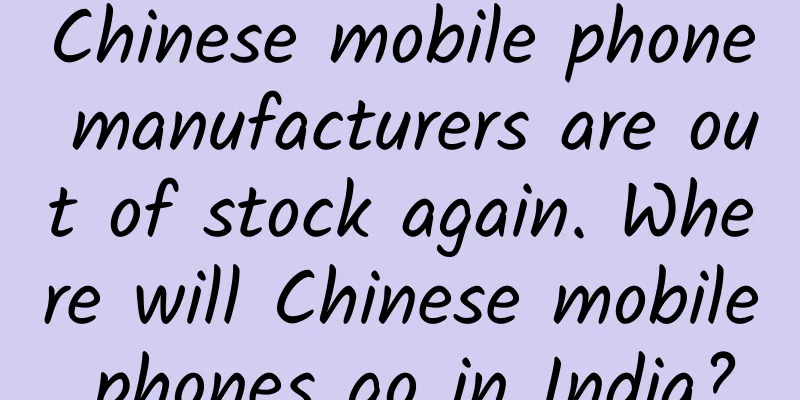Chinese mobile phone manufacturers are out of stock again. Where will Chinese mobile phones go in India?

|
"It just recovered a little, but now it's out of stock again." A senior executive of a Chinese mobile phone brand told Zhixiang.com. On the other end of the phone, he was in a third-tier city in southern Mumbai. "Whether it's OPPO or vivo, there are only a few phones in the store." The last "supply cut" was in early July, when a conflict broke out on the China-India border. Indian customs forcibly obstructed the clearance of goods from China, causing many Chinese factories to stop production. This time, although it is not targeted at China, the reason is equally very "Indian": customs clearance of Chinese electronic products was delayed due to system problems, and some mobile phone brands were out of stock. Recently, the Indian Customs’ newly launched Faceless Assessment System has affected innocent people. The Indian Cellphone Industry Association ICEA also complained that the customs clearance time has increased from 2 to 3 days to 8 to 12 days. There is also a more worrying problem for Chinese mobile phone companies. Due to geopolitical uncertainties, the grand "Indian dream" that Chinese mobile phones are entangled with has been covered in dust. India has begun to implement the PTI plan for "self-reliance" in manufacturing. According to the plan, government departments will provide 400 billion rupees (about 5.3 billion US dollars) in financial support over the next five years to stimulate the development of India's electronic manufacturing industry, and it is expected to achieve a total output value of 153 billion US dollars within five years. But this ambitious plan has excluded China. However, Chinese mobile phone brands account for nearly 80% of the Indian mobile phone market share. According to data from research firm IDC, in 2019, Xiaomi shipped 43.6 million units in India, ranking first with a market share of 28.6%. Vivo shipped 23.8 million units, ranking third with a market share of 15.6%. OPPO and Realme shipped 16.3 million and 16.2 million units respectively, ranking fourth and fifth with market shares of 10.7% and 10.6%. IDC 2019 India Mobile Phone Market Report Just a few months ago, Chinese brands were ambitious in India and planned to invest heavily. In March 2019, Xiaomi invested 35 billion rupees (about 470 million U.S. dollars) in two batches in Xiaomi India, which was the largest investment since Xiaomi entered India. Vivo also stated in August 2019 that it would invest 75 billion rupees (about 1 billion U.S. dollars) in the next few years to expand its production capacity, which would become the largest investment in India's manufacturing industry. In early 2020, OPPO also stated that it would expand its production line in India and double its production capacity by the end of the year. Now, the "Indian Dream" is fading away Chinese mobile phone companies have stopped supplying to India for the second time, caused by the automatic customs clearance system being implemented by the Indian government. The automatic customs clearance system is a major component of the "Turant Custom" program that India is implementing. Its purpose is to improve customs clearance efficiency through information technology. However, since it has just been implemented, customs officials have made deviations in actual operations, resulting in an increase in customs clearance time of 8 to 10 days. This puts pressure on many companies. The Indian Cellular and Electronics Association (ICEA) has requested that a green channel be opened for all operators and manufacturing entities, without the need for automatic clearance assessment. This will enable faster replenishment of capacity and improved business continuity," said Pankaj Mohindroo, president of the association. ICEA members include brands such as Xiaomi, vivo, OPPO, Apple, Foxconn, Lava, Micromax and Karbonn. ICEA explained that under the new automatic customs clearance assessment system, the goods may be at port A, but the document data uploaded to the customs system will be randomly assigned to the assessment officer (AO) at port B by the algorithm. ICEA members said that the assessment officers would go back and forth many times and check the documents in detail. This has caused the customs clearance time to increase to 8 to 12 days, and the average is six to seven days, which has disrupted their entire plan," said Mohindro. Currently, ICEA is seeking exemptions for electronic products so that they do not have to go through the automatic customs clearance route, thereby reducing customs clearance time. Although it is not aimed at Chinese companies, the Indian government has been taking continuous actions. On August 5, the media reported that the Bureau of Indian Standards (BIS) postponed the import approval of mobile phone components and televisions, and Chinese companies including Xiaomi and OPPO are expected to be affected. In April this year, India announced that it would implement BIS mandatory certification inspections on 12 products including Bluetooth headsets and keyboards starting October 1. India Today said that the Indian government is considering imposing import restrictions on more than 370 Chinese products, which are expected to be implemented before March 2021. The Indian government, which had previously urged and attracted Chinese investment, is now stepping up its efforts to "decouple" from China in the mobile phone industry chain. The manufacturer with the largest mobile phone market share has been excluded The Indian government is trying to please Japanese, South Korean, American and Taiwanese companies. On September 7, Indian Minister of Communications and Information Technology Ravi Shankar Prasad said, "India is emerging as a major manufacturing center, and the global manufacturing ecosystem realizes that it must find places other than China to set up factories." On September 7, the Indian government approved export applications from a series of mobile phone manufacturers. These companies were all from mobile phone manufacturers selected for India's production stimulus plan, including iPhone contract manufacturers Foxconn, Pegatron, Wistron, as well as Samsung, Karbonn, Lava and Dixon, etc., and are expected to export mobile phones with a total value of US$100 billion. However, there are no Chinese mainland companies on the list, including Xiaomi, OPPO, vivo, etc., which have set up factories in India. People familiar with the matter said that Foxconn and Samsung have each submitted estimates of mobile phone production capacity worth US$50 billion in the next five years. The story dates back to April 1, when the Indian Ministry of Communications and Information Technology drafted a plan to strengthen India's electronics manufacturing industry and welcomed mobile phone manufacturers from all over the world to invest and set up factories in India. The full name of this plan is "Production Linked Incentive Plan for Large Electronics Manufacturing in India" (PTI Plan). Its content shows that India plans to spend more than 400 billion rupees (about 5.3 billion US dollars) in the next five years to stimulate the development of India's electronics manufacturing industry. Specifically, in the next five years, the Indian government will provide 6% financial incentives to these companies based on their sales in fiscal years 2019 to 2020 for goods produced in India that exceed their sales in that year. In addition, Prasad also promised to provide a 25% incentive for capital expenditures on the production of electronic components, semiconductors and other parts. However, as of the end of the application period for the program on July 31, no mainland Chinese mobile phone manufacturer participated. Among the 22 applications obtained by the Indian Technology News, the foreign companies that have been approved include Samsung Electronics, two factories under Foxconn, Wistron, and Pegatron. The selected Indian local manufacturers are Lava, Dixon, Micromax, Padget Electronics, Sojo, Karbonn, and Optiemus. On August 1, Indian Minister of Communications and Information Technology Ravi Shankar Prasad announced at a press conference that five Apple partners including Samsung Electronics and Foxconn have pledged to invest 110 billion rupees (US$1.5 billion) to set up factories in India to manufacture mobile phones. This move will increase the output value of mobile phones manufactured in India to 11.5 trillion rupees (US$156 billion) in the next five years. In response to the question of why no companies from mainland China were selected, Prasad publicly responded at a press conference that "the government does not prevent companies from any country from participating in this plan." Taiwan's Foxconn and Wistron have set up factories in India to manufacture iPhones for Apple and are expanding their production capacity. In July, Foxconn's factory began producing iPhone 11, the first time that Apple's top-end model was produced in India; Pegatron, another Apple's second largest contract manufacturer, also reportedly applied to set up a branch in Chennai in July and is looking for a site to set up a factory. It is also in talks with Uttar Pradesh, Karnataka and Andhra Pradesh in India. Foxconn mobile phone factory in Tamil Nadu, India/Bloomberg Currently, Samsung exports about $2.5 billion worth of mobile phones from India. The South Korean electronics manufacturer plans to produce $50 billion worth of mobile phones in the next five years, of which $40 billion will be made up of mid- to high-end models with a factory price of more than $200. In a media interview on September 7, Prasad no longer shy away from his policy attitude towards China. He said that in the Ladakh conflict, he stood on the side of the Prime Minister, and that the bold steps taken by India against China had been recognized by the United States, Britain, Japan and Australia. |
<<: Google's secret to staying technologically competitive: global-scale engineering first
Recommend
Do the pigments in ultra-processed foods really cause cancer?
Key Points ★ Most snacks, drinks, desserts, and i...
12 Popular Enzyme Reviews: Can Enzymes Really Help You Lose Weight? Can They Help You Moisten Your Intestines and Have a Laxative Effect?
When it comes to enzymes, the most common effects...
Can Samsung Galaxy Tab S2 win the hearts of consumers in the face of the tablet industry's recession?
Today, the development of the global tablet compu...
Lanzhou fresh food WeChat mini program function, how much does it cost to develop a fresh food WeChat mall mini program?
With the continuous advancement of the Internet, m...
Low-temperature burns may cause cancer! How to use portable heating equipment safely?
The first cold wave of the year is coming! Recent...
Li Lei's 12 voice acting lessons
Course Catalog: ├──01.Teach you how to hold your ...
Short video competitive product analysis report!
Short video apps occupy a large amount of people&...
It was discovered that Mars had a magnetic field earlier than previously expected, 4.5 billion years ago!
[Mobile software: Bo Ke Yuan] Mars had a global m...
What does server rental mean? What is the difference between renting a server abroad and renting a server in China?
What is the difference between renting a server a...
Top ten crisis public relations events in 2018!
Looking back at the year 2018, the public relatio...
Will Samsung become the next Sony?
Recently, there is news that Sony Mobile will sig...
User Growth Tips
The background for writing this article is due to...
A must-have for operations, promotion and marketing: a complete list of the latest hot topics in July 2017!
Nowadays, chasing hot topics has become one of th...
Super useful information! Check out which websites the operations experts usually visit and save them quickly!
For those who work in operations , who doesn’t ha...
How to promote bidding? Just read this article!
As a newbie in bidding, you may have this questio...









